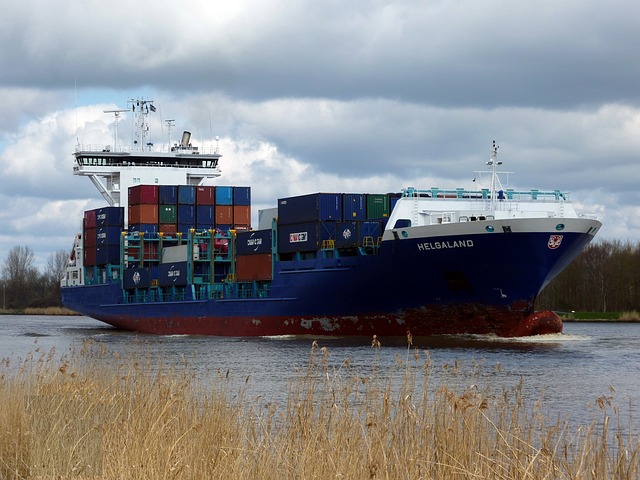Conex containers, with standard 20ft and 40ft sizes, offer flexible shipping solutions based on specific dimensions. Key considerations include usable cargo space, door openings, and load capacities. 20ft containers measure approx. 6m x 2.44m x 2.59m, while 40ft containers double the length at 12.19m. Conex high cube models provide increased interior volume for specialized cargo needs. Custom handling equipment required for efficient loading of oversized or valuable goods.
In the realm of international shipping, understanding container sizes is paramount for efficient logistics. This article delves into a critical comparison between Conex and standard shipping containers, with a focus on their dimensions. We’ll explore Conex container sizes, dissecting their unique aspects versus the more common standard varieties. From interior space to load capacities, this guide covers essential considerations for carriers, ensuring informed choices in navigating global trade.
- Understanding Conex Container Sizes: An Overview
- Standard Shipping Containers: Dimensions and Varieties
- Comparing Interior Space: Conex vs. Standard
- Load Capacity and Weight Limits: A Detailed Look
- Handling and Transportation Considerations: Similarities and Differences
Understanding Conex Container Sizes: An Overview

Conex containers come in various sizes to cater to diverse shipping needs, each with specific dimensions that define their capacity and utility. The most common standards include the 20ft and 40ft conex containers, offering versatile solutions for global cargo transport. Beyond these standard measures, there are specialized options like high cube containers, which provide extra headroom for bulky goods, and narrow or wide versions tailored to specific cargo shapes and spaces.
Understanding the internal dimensions—including floor space, ceiling height, and door opening sizes—is crucial for determining a container’s usability. For instance, 20ft conex high cube containers offer slightly different internal dimensions compared to their standard counterparts, with enhanced vertical clearance beneficial for heavy or oversized items. Similarly, conex reefer, flat rack, open top, and office containers have unique dimension profiles optimized for specialized cargo types and configurations, such as temperature-controlled transport or additional interior workspace.
Standard Shipping Containers: Dimensions and Varieties

Standard Shipping Containers, a cornerstone in global logistics, come in various sizes and designs to cater to diverse shipping needs. When it comes to dimensions, these containers are measured in length, width, and height, typically offered in standard metric or imperial units. The most common types include the 20ft and 40ft conex containers, each with specific internal and external dimensions.
For instance, a standard 20ft conex container has an exterior dimension of approximately 6.06m (20 feet) in length, 2.44m (8 feet) in width, and 2.59m (8.5 feet) in height. Its internal dimensions are slightly smaller due to the structure and door mechanisms, with a typical usable cargo space of around 3.76m (12.3 feet) length, 2.34m (7.7 feet) width, and 2.44m (8 feet) ceiling height. The 40ft conex container, as the name suggests, offers double the length at approximately 12.19m (40 feet), with comparable width and height dimensions to its smaller counterpart. These containers, with their varied dimensions and customizable features like door openings and special clearances for reefer units or flat rack configurations, provide versatility in transporting a wide range of goods.
Comparing Interior Space: Conex vs. Standard

When comparing the interior space between Conex and standard shipping containers, one of the primary factors to consider is the overall dimensions. Conex containers are known for their versatile and customizable nature, offering various sizes to suit different needs. The 20ft Conex container dimensions typically provide a usable cargo space of approximately 14.6m3, with internal dimensions of around 3.75m (width) x 2.1m (height) x 12.8m (length). Similarly, the 40ft Conex container dimensions offer a spacious interior, measuring about 3.8m (width) x 2.3m (height) x 12.2m (length), providing nearly twice the volume of its smaller counterpart.
These internal dimensions include the usable cargo space, but it’s essential to also consider the conex container door opening dimensions, which can impact loading and unloading efficiency. The standard door sizes for Conex containers are designed to accommodate various loading equipment, ensuring easy access. For instance, a 20ft Conex high cube container has external dimensions of approximately 6.1m (width) x 2.44m (height) x 13.7m (length), and its internal dimensions, excluding the door clearance, are around 3.6m (width) x 2.2m (height) x 12.5m (length). These dimensions ensure that the container is not only spacious but also versatile enough to accommodate a wide range of cargo types.
Load Capacity and Weight Limits: A Detailed Look

Cargo containers, be they standard or specialized like the Conex (ISO) variety, are designed to carry a wide range of goods, each with specific weight and space requirements. The load capacity and weight limits of a Conex container are determined by its dimensions, construction, and intended use. For instance, a 20ft Conex container has external dimensions of approximately 20′ x 8′ x 8.5′ (width x length x height), with internal dimensions slightly smaller due to the structure required for door operation. The load capacity can range from 21-24 tons, depending on factors like floor strength and ceiling height.
When comparing Conex containers to standard shipping options, it’s crucial to understand that Conex containers are designed for intermodal transport – they can be easily moved between different modes of transportation, such as ships, trucks, and rail cars. This versatility comes at the cost of specific dimensions that may not always match standard cargo pallets or loading bays. For example, a 40ft Conex container has larger external dimensions of about 40′ x 8′ x 9.5′, offering more usable cargo space but also heavier weight limits, typically up to 27-30 tons. Specific dimensions like door opening sizes, ceiling heights, and floor strengths vary between Conex containers designed for different purposes (e.g., reefer, flat rack, open top) and must be considered when planning the transportation of specific types of cargo.
Handling and Transportation Considerations: Similarities and Differences

Handling and Transportation Considerations: Similarities and Differences
When it comes to handling and transportation, both standard shipping containers and Conex (intermodal steel transport units) share many commonalities due to their universal design for easy stacking and transfer between modes of transport. However, there are distinct differences in dimensions that play a crucial role in optimizing space utilization and load configurations. The 20ft and 40ft Conex container dimensions, for instance, align with ISO standards, making them interchangeable across various global ports and transport networks. This standardization facilitates efficient stacking and loading procedures, which is particularly beneficial for bulk cargo shipping.
One key difference lies in the internal dimensions of Conex containers compared to standard shipping containers. Conex high cube containers, such as the 20ft and 40ft variants, offer increased usable cargo space due to their optimized internal dimensions. This becomes especially important for specialized cargo that requires specific clearances or configurations, like refrigerated (reefer) or flat rack containers. Furthermore, the door opening dimensions in Conex containers are designed for quick and efficient loading, often requiring custom handling equipment to accommodate their unique hinge mechanism. These considerations are essential when planning the transportation of unconventional or high-value cargo.
When comparing conex container dimensions to standard shipping containers, understanding their distinct sizes and capabilities is key. While both serve essential roles in global logistics, conex containers offer unique advantages with their specialized interior space and specific load handling requirements. This detailed comparison highlights the differences in dimensions, load capacity, and handling, empowering businesses to make informed choices based on their specific shipping needs.
